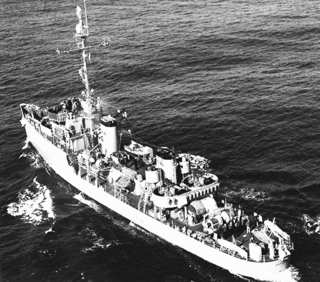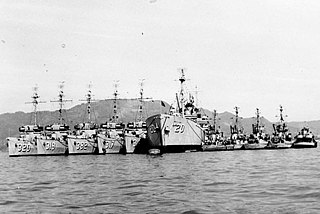
USS Defense (AM-317) was an Auk-class minesweeper acquired by the United States Navy for the dangerous task of removing mines from minefields laid in the water to prevent ships from passing.

USS Shelter (AM-301) was an Admirable-class minesweeper built for the United States Navy during World War II. After service in the Pacific during World War II, Shelter was decommissioned in June 1946 and placed in reserve. In January 1964, she was transferred to South Vietnam for service in the Republic of Vietnam Navy as RVNS Chi Linh (HQ-11). She remained in South Vietnamese service until the collapse of that country in 1975. Chi Linh was one of several ships that fled from South Vietnam to the Philippines. She was then commissioned into the Philippine Navy in April 1976 as RPS Datu Tupas (PS-18), named after a chieftain of Cebu. The ship's fate is not reported in secondary sources.

USS Starling (AM-64) was an Auk-class minesweeper acquired by the United States Navy for the dangerous task of removing mines from minefields laid in the water to prevent ships from passing.
The second USS Scoter (AM-381) was an Auk-class minesweeper acquired by the United States Navy for the dangerous task of removing mines from minefields laid in the water to prevent ships from passing. Scoter was named after the word "Scoter," which is a mercantile name retained during service in the United States Navy.

USS Gladiator (AM-319) was an Auk-class minesweeper acquired by the U.S. Navy for the dangerous task of removing mines from minefields laid in the water to prevent ships from passing.

USS Triumph (AM-323) was a World War II Auk-class minesweeper of the United States Navy.

USS Chief (AM-315) was an Auk-class minesweeper acquired by the United States Navy for the dangerous task of removing mines from minefields laid in the water to prevent ships from passing, and named after the word "chief," the head or leader of a group.

The third USS Champion (BAM-1/AM-314/MSF-314) was an Auk-class minesweeper of the United States Navy.
USS Facility (AM-233) was an Admirable-class minesweeper built for the United States Navy during World War II. The ship was ordered and laid down as PCE-905-class patrol craft USS PCE-906 but was renamed and reclassified before her June 1944 launch as Facility (AM-233). After earning three battle stars for service in the Pacific during World War II, she was decommissioned in September 1946 and placed in reserve. While in reserve, Facility was reclassified as MSF-233 in February 1955 but never reactivated. In October 1962, she was sold to the Mexican Navy and renamed ARM DM-04. Her ultimate fate is not reported in secondary sources; she may have been out of service by April 1973 when another member of the Admirable class was acquired by the Mexican Navy and given the name DM-04.
USS Success (AM-310) was an Admirable-class minesweeper built for the United States Navy during World War II. She was awarded four battle stars for service in the Pacific during World War II. She was decommissioned in July 1946 and placed in reserve. While she remained in reserve, Success was reclassified as MSF-310 in February 1955 but never reactivated. In October 1962, she was sold to the Mexican Navy and renamed ARM DM-08. Although she is reported out of service, her ultimate fate is not reported in secondary sources.
USS Design (AM-219) was a steel-hulled Admirable class minesweeper built for the U.S. Navy during World War II. A crew, trained in minesweeping, boarded the new vessel, and proceeded to the Pacific Ocean to clear minefields so that Allied forces could safely invade Japanese-held beaches. For this dangerous work under combat conditions she was awarded three battle stars.
USS Compel (AM-162) was an Admirable-class minesweeper built for the U.S. Navy during World War II. She was built to clear minefields in offshore waters, and served the Navy in the Pacific Ocean. Compel was awarded one battle star for World War II service.
USS Device (AM-220) was an Admirable-class minesweeper built for the United States Navy during World War II. She was awarded three battle stars for service in the Pacific during World War II. She was decommissioned in August 1946 and placed in reserve. Although she did not see service in the war zone, Device was recommissioned in March 1950 during the Korean War and remained in commission until February 1954, when she was placed in reserve again. While she remained in reserve, Device was reclassified as MSF-220 in February 1955 but never reactivated. In October 1962, she was sold to the Mexican Navy and renamed ARM DM-11. In 1994 she was renamed ARM Cadete Agustín Melgar (C54), spelled Augustín Melgar in some sources. She was stricken in 2000, and scuttled for use as an artificial reef in Bahía de Loreto National Park.
USS Diploma (AM-221) was an Admirable-class minesweeper built for the United States Navy during World War II. She was awarded three battle stars for service in the Pacific during World War II. She was decommissioned in September 1946 and placed in reserve. While she remained in reserve, Diploma was reclassified as MSF-221 in February 1955 but never reactivated. In 1962, she was sold to the Mexican Navy and renamed ARM DM-17. In 1994 she was renamed ARM Cadete Francisco Márquez (C59). She was stricken in 2000, in 2004 she was cleaned of contaminants and sunk as an artificial reef on the west coast of Isla Espiritu Santo, off La Paz BCS, Mexico. She is a popular local dive site, The C59, and is resting on her side at 70'/20m to 30'/9m of depth.

USS Dour (AM-223) was an Admirable-class minesweeper built for the United States Navy during World War II. She was awarded three battle stars for service in the Pacific during World War II. She was decommissioned in March 1947 and placed in reserve. While she remained in reserve, Dour was reclassified as MSF-223 in February 1955 but never reactivated. In October 1962, she was sold to the Mexican Navy and renamed ARM DM-16. She was stricken from Mexican Navy service in 1986, but her ultimate fate is not reported in secondary sources.
USS Eager (AM-224) was an Admirable-class minesweeper built for the United States Navy during World War II. She was awarded 1 battle star during service in the Pacific in World War II. She was decommissioned in September 1946 and placed in reserve. While she remained in reserve, Eager was reclassified as MSF-224 in February 1955 but never reactivated. In October 1962, she was sold to the Mexican Navy and renamed ARM DM-06. She was stricken in 1986, but her ultimate fate is not reported in secondary sources.
USS Hilarity (AM-241) was an Admirable-class minesweeper built for the United States Navy during World War II. She was awarded two battle stars for service in the Pacific during World War II. She was decommissioned in 1946 and placed in the Atlantic Reserve Fleet. While she remained in reserve, Hilarity was reclassified as MSF-241 in February 1955 but never reactivated. In October 1962, she was sold to the Mexican Navy and renamed ARM DM-02. She was stricken in 1986 and scrapped in August 1988.
USS Ransom (AM-283) was an Admirable-class minesweeper built for the United States Navy during World War II. She was awarded three battle stars for service in the Pacific during World War II. She was decommissioned in March 1947 and placed in reserve. Although she did not see service in the war zone, Ransom was recommissioned in March 1951 during the Korean War and remained in commission until September 1953, when she was placed in reserve again. While she remained in reserve, Ransom was reclassified as MSF-283 in February 1955 but never reactivated. In 1962 she was sold to the Mexican Navy and renamed ARM DM-12. In 1994 she was renamed ARM Teniente Juan de la Barrera (C55). She was stricken in 2000, but her ultimate fate is not reported in secondary sources.
USS Rebel (AM-284) was an Admirable-class minesweeper built for the United States Navy during World War II. She was awarded four battle stars for service in the Pacific during World War II. She was decommissioned in June 1946 and placed in reserve. While she remained in reserve, Rebel was reclassified as MSF-284 in February 1955 but never reactivated. In October 1962, she was sold to the Mexican Navy and renamed ARM DM-14. In 1994 she was renamed ARM Cadete Fernando Montes de Oca (C57). She was stricken in July 2001, but her ultimate fate is not reported in secondary sources.
USS Recruit (AM-285) was an Admirable-class minesweeper built for the United States Navy during World War II. She was awarded 3 battle stars for service in the Pacific during World War II. She was decommissioned in August 1946 and placed in reserve. While she remained in reserve, Recruit was reclassified as MSF-285 in February 1955 but never reactivated. In 1963, she was sold to the Mexican Navy and renamed ARM DM-07. Although she is reported out of service, her ultimate fate is not reported in secondary sources.







